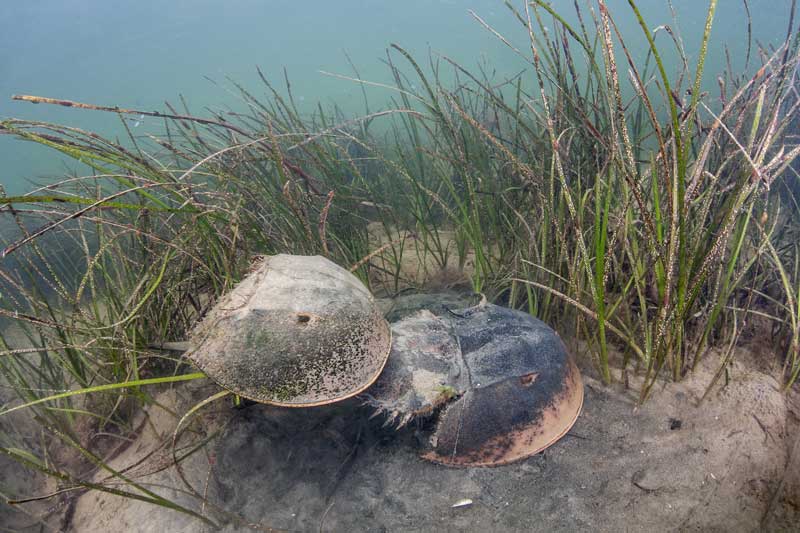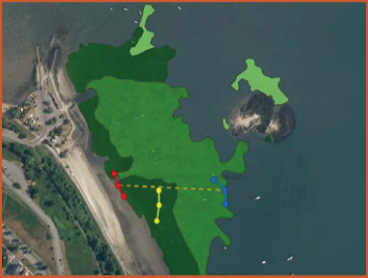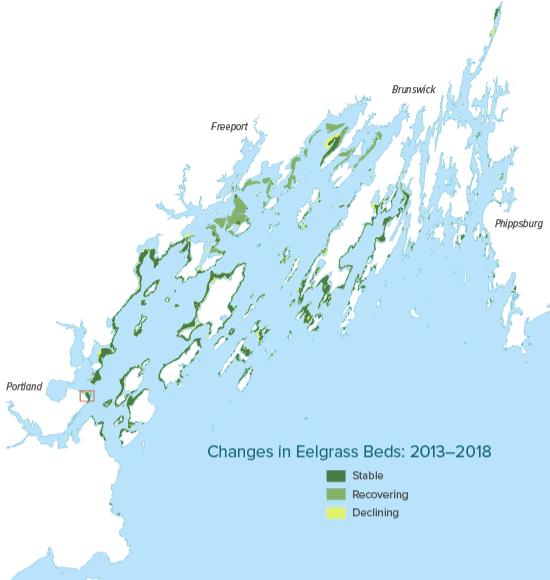Eelgrass Increased from 2013 to 2018
But Remains Below Historical Abundance
Beds in Freeport and Brunswick Rebounded Through Natural Propagation
WHY IT MATTERS
Eelgrass (Zostera marina) is a seagrass that forms extensive subtidal beds in sheltered areas where sunlight penetrates to its slender leaves. Eelgrass plays many vital roles in the Casco Bay ecosystem. Its beds serve as nursery habitat for young fish, while providing food for fish, shellfish, and migratory birds. Eelgrass helps to remove sediments and excess nutrients from the water, and its roots stabilize sediments. Abundant eelgrass indicates a healthy ecosystem, as eelgrass both contributes to and depends on good water quality.
Eelgrass beds contribute to climate resilience in important ways. They buffer ocean and coastal acidification by absorbing carbon dioxide and raising pH levels in the water. They provide “blue carbon” benefits by storing organic carbon in their underground biomass and sediments. They dampen wave energy near shorelines, reducing storm damage and erosion.
STATUS & TRENDS
Mapping of Casco Bay’s eelgrass beds by Maine Department of Environmental Protection (DEP) in 2018 showed an increase in total area since widespread losses documented in 2013, associated with a rapid increase in the local population of European green crab (Carcinus maenas). However, total area remained over 30 percent lower than levels documented in 1993-94 and 2001-02. Beds characterized by intermediate to dense eelgrass—40 to 100 percent cover—contributed most of the expansion.
STATUS & TRENDS
Mapping of Casco Bay’s eelgrass beds by Maine Department of Environmental Protection (DEP) in 2018 showed an increase in total area since widespread losses documented in 2013, associated with a rapid increase in the local population of European green crab (Carcinus maenas). However, total area remained over 30 percent lower than levels documented in 1993-94 and 2001-02. Beds characterized by intermediate to dense eelgrass—40 to 100 percent cover—contributed most of the expansion.
Changes in Acres of Eelgrass Beds
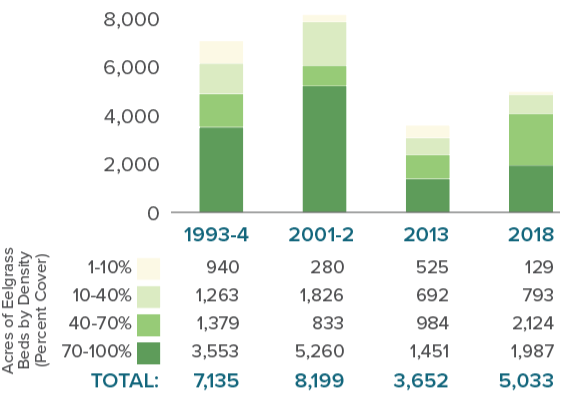
Comparison of Depth of Eelgrass Bed Deep Edge and Light Attenuation at Three Sites
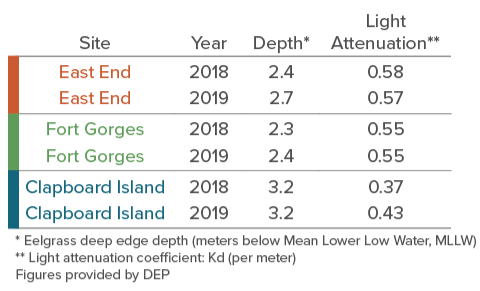
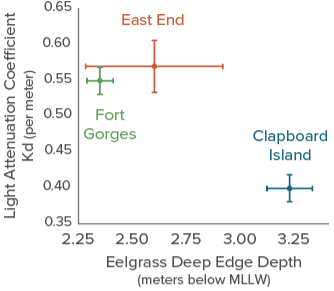
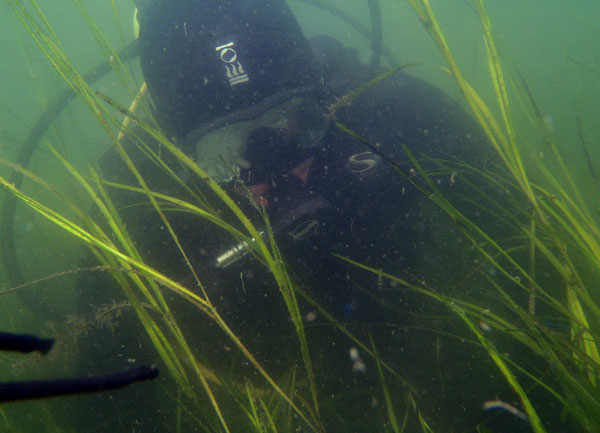
Dive Surveys by Maine DEpartment of environmental protection
Twice each year beginning in 2018, the Maine Department of Environmental Protection (Maine DEP) Marine Dive Team has assessed the health of eelgrass beds at Fort Gorges, Clapboard Island, and Portland’s East End Beach. Along fixed transects that run parallel to shore and are located from the bed’s shallow edge to its deep edge, the divers monitor shoot density, percent cover, canopy height, and other parameters. The purpose of the monitoring is to document bed condition and trends, and to correlate those findings with water quality measurements to understand whether efforts to reduce nitrogen discharges at nearby wastewater treatment facilities are resulting in improvements to eelgrass health.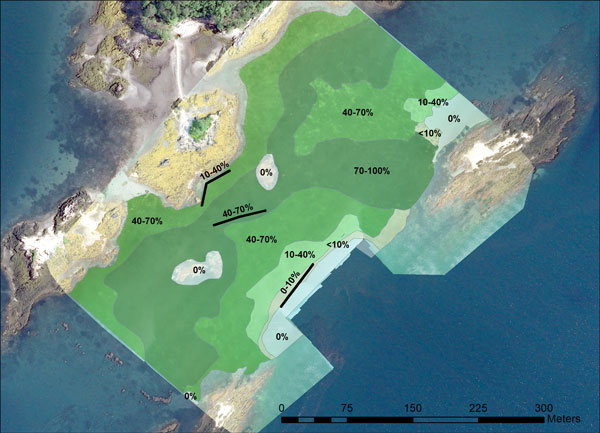
New Methods for Mapping Eelgrass
Drone imagery is increasingly being used for eelgrass monitoring and mapping. New drone sensors and technologies are expected to allow better detection of eelgrass deep edges and development of algorithms to assess important health metrics, such as epiphyte load.Threats
- Eelgrass is vulnerable to small changes in light penetration through the water. Poor water clarity results from suspended sediments and algal blooms, which are caused by excess nitrogen, dredging projects, and other human activities. Aerial and dive surveys in Casco Bay are designed to document any changes in eelgrass quantity and health in response to nitrogen load reductions over time.
- Invasive European green crabs often clip or dig up eelgrass as they hunt for shellfish. Invasive colonial tunicates also pose a threat. When growing on eelgrass, the tunicates cover photosynthetic tissues and weigh down eelgrass blades, reducing access to light.
- Mooring chains, anchors, boat propellers, and bottom-dragging fishing gear can cause severe damage to eelgrass beds.
View a PDF version of this page that can be downloaded and printed.
View references, further reading, and a summary of methods and data sources.
STATE OF CASCO BAY
Drivers & Stressors
What’s Affecting the Bay?
Human Connections
What’s Being Done?
If you would like to receive a printed State of Casco Bay report, send an email request to cbep@maine.edu.
This document has been funded by the U.S. Environmental Protection Agency under Cooperative Agreements #CE00A00348-0 and #CE00A00662-0 with the University of Southern Maine.
Suggested citation: Casco Bay Estuary Partnership. State of Casco Bay, 6th Edition (2021).
